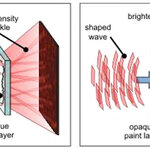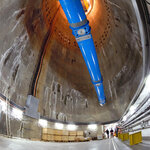Physics

When an electrical current passes through a wire it emanates heat – that's where we get toasters and the light bulbs Al Gore hates - but some materials violate this rule at low temperatures and carry current without any heat loss.
That's where we get superconductor research.
Andrea Bianchi, a professor in the Department of Physics at the Université de Montréal, and his colleagues say that, contrary to previous belief, superconductivity can induce magnetism, which has raised a new quantum conundrum.
The transport of electric current in a conductor is associated with the displacement of…

University of Chicago scientists have discovered how to make magnetic sensors capable of operating at the high temperatures that ceramic engines in cars and aircraft of the future will require for higher operating efficiency than today's internal combustion technology.
The key to fabricating the sensors involves slightly diluting samples of a well-known semiconductor material, called indium antimonide, which is valued for its purity. Chicago's Thomas Rosenbaum and associate Jingshi Hu, now of the Massachusetts Institute of Technology, have published their formula in the September issue of…

Safety has to be based on evidence. Should probing the secrets of the universe create a global threat? Is it relevant to bring up Marie Curie in safety arguments for unkown or complicated physics? How about the past nuclear fission research?
Fast reactors are a good example of known physics guiding the research for the missing experimental data such as the Doppler Coefficient. SEFOR was built just to make the needed measurements to assure the inherent safety of a fast reactor core. Later, indeed, EBR-II confirmed the correctness of this inherent feature of the fast reactors. It was shutdown…

In one week from today, the Large Hadron Collider(LHC) will take its first step 'back in time.' What is mass? What happened at the beginning of the universe? Are there other dimensions? We'll be on the way to finding out.
It's taken about 6,000 researchers, been over budget and behind schedule but it's finally ready to go.
If all goes according to plan, the superconducting magnets in the collider will zap atomic particles around the 17-mile tunnel at roughly the speed of light. Then the scientists will smash the particles together, replicating what happened mere nanoseconds after the…

Materials such as milk, paper, white paint and tissue are opaque because they scatter light, not because they absorb it, but no matter how great the scattering, light was always able to get through the material in question, went the theory.
Researchers Ivo Vellekoop and Allard Mosk of the University of Twente have now shaped the waveform of light and confirmed this with experiments. By doing so they have found the predicted ‘open channels’ in material along which the light is able to move.
In materials that have a disordered structure, incident light is scattered in every direction possible…

FLEMING DOES NOT RULE OK!
These could be what Physics World calls Lateral Thoughts, because I originally wrote this horizontally with my leg in plaster. Here follow some snapshots of my journey through Physics, which is not a straightforward one like that of Marco Polo, but a meandering one like that of the 14th century Moroccan traveller Ibn Battuta. But this is no random selection, but a selected album entitled “Electromagnetism.”
The prologue to this tale finds me as a pre-teenager in the mid 1950’s, poring over my Pictorial Encyclopaedia. I eagerly drink in the graphical information…

The field of particle physics is poised to enter unknown territory with the startup of a massive new accelerator--the Large Hadron Collider (LHC)--in Europe this summer. On September 10, LHC scientists will attempt to send the first beam of protons speeding around the accelerator.
The LHC will put hotly debated theories to the test as it generates new experimental data. Potential breakthroughs include an explanation of what gives mass to fundamental particles and identification of the mysterious dark matter that makes up most of the mass in the universe. More exotic possibilities include…

Fast memory chips such as DRAMs and SRAMs (Dynamic and Static Random Access Memory) commonly used today have one decisive disadvantage: in case of power interruption, they lose their stored information. This problem could be solved by magnetic memory chips called MRAMs (Magnetic Random Access Memory). In MRAM the digital information is not stored by means of electric charge but by means of the orientation of the magnetization of a magnetic cell.
An experiment carried out at the Physikalisch-Technische Bundesanstalt (PTB) has realized spin torque switching of a nanomagnet as fast as the…

Organic semiconductor or “plastic” LEDs are much cheaper and easier to fabricate than existing inorganic LEDs now used in traffic signals, some building lighting and as indicator lights on computers, TVs, cell phones, DVD players, modems, game consoles and other electronics.
A new study by University of Utah physicists suggests it will be more difficult than thought to make highly efficient light-emitting diodes (LEDs) using organic materials. Their findings hint such LEDs would convert no more than 25 percent of electricity into light rather than heat, contrary to earlier estimates of up to…

Recently some people have disputed the existence of the NEUTRON, which if this had any sound basis would cast doubt on some of my recent activities. Maybe this is because the neutron has not had much of an impact in popular culture. The only item that I remember is a song Yes to the Neutron Bomb (1981) by the Liverpool Group “Moderates”.
I first went a-neutron scattering about three years ago. I arrived at the Rutherford Appleton Laboratory near Oxford, and went to the ISIS facility. After getting my badge and doing the safety test, I walked through the experimental hall (picture) and…